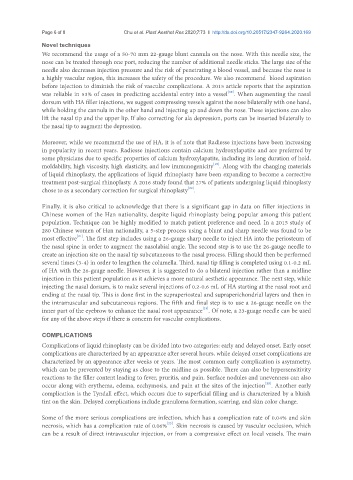Page 884 - Read Online
P. 884
Page 6 of 8 Chu et al. Plast Aesthet Res 2020;7:73 I http://dx.doi.org/10.20517/2347-9264.2020.169
Novel techniques
We recommend the usage of a 50-70 mm 22-gauge blunt cannula on the nose. With this needle size, the
nose can be treated through one port, reducing the number of additional needle sticks. The large size of the
needle also decreases injection pressure and the risk of penetrating a blood vessel, and because the nose is
a highly vascular region, this increases the safety of the procedure. We also recommend blood aspiration
before injection to diminish the risk of vascular complications. A 2015 article reports that the aspiration
[18]
was reliable in 53% of cases in predicting accidental entry into a vessel . When augmenting the nasal
dorsum with HA filler injections, we suggest compressing vessels against the nose bilaterally with one hand,
while holding the cannula in the other hand and injecting up and down the nose. These injections can also
lift the nasal tip and the upper lip. If also correcting for ala depression, ports can be inserted bilaterally to
the nasal tip to augment the depression.
Moreover, while we recommend the use of HA, it is of note that Radiesse injections have been increasing
in popularity in recent years. Radiesse injections contain calcium hydroxylapatite and are preferred by
some physicians due to specific properties of calcium hydroxylapatite, including its long duration of hold,
[19]
moldability, high viscosity, high elasticity, and low immunogenicity . Along with the changing materials
of liquid rhinoplasty, the applications of liquid rhinoplasty have been expanding to become a corrective
treatment post-surgical rhinoplasty. A 2016 study found that 27% of patients undergoing liquid rhinoplasty
[20]
chose to as a secondary correction for surgical rhinoplasty .
Finally, it is also critical to acknowledge that there is a significant gap in data on filler injections in
Chinese women of the Han nationality, despite liquid rhinoplasty being popular among this patient
population. Technique can be highly modified to match patient preference and need. In a 2015 study of
280 Chinese women of Han nationality, a 5-step process using a blunt and sharp needle was found to be
[21]
most effective . The first step includes using a 26-gauge sharp needle to inject HA into the periosteum of
the nasal spine in order to augment the nasolabial angle. The second step is to use the 26-gauge needle to
create an injection site on the nasal tip subcutaneous to the nasal process. Filling should then be performed
several times (3-4) in order to lengthen the columella. Third, nasal tip filling is completed using 0.1-0.2 mL
of HA with the 26-gauge needle. However, it is suggested to do a bilateral injection rather than a midline
injection in this patient population as it achieves a more natural aesthetic appearance. The next step, while
injecting the nasal dorsum, is to make several injections of 0.2-0.6 mL of HA starting at the nasal root and
ending at the nasal tip. This is done first in the supraperiosteal and supraperichondrial layers and then in
the intramuscular and subcutaneous regions. The fifth and final step is to use a 26-gauge needle on the
inner part of the eyebrow to enhance the nasal root appearance . Of note, a 23-guage needle can be used
[21]
for any of the above steps if there is concern for vascular complications.
COMPLICATIONS
Complications of liquid rhinoplasty can be divided into two categories: early and delayed onset. Early onset
complications are characterized by an appearance after several hours, while delayed onset complications are
characterized by an appearance after weeks or years. The most common early complication is asymmetry,
which can be prevented by staying as close to the midline as possible. There can also be hypersensitivity
reactions to the filler content leading to fever, pruritis, and pain. Surface nodules and unevenness can also
[22]
occur along with erythema, edema, ecchymosis, and pain at the sites of the injection . Another early
complication is the Tyndall effect, which occurs due to superficial filling and is characterized by a bluish
tint on the skin. Delayed complications include granuloma formation, scarring, and skin color change.
Some of the more serious complications are infection, which has a complication rate of 0.04% and skin
[23]
necrosis, which has a complication rate of 0.06% . Skin necrosis is caused by vascular occlusion, which
can be a result of direct intravascular injection, or from a compressive effect on local vessels. The main

